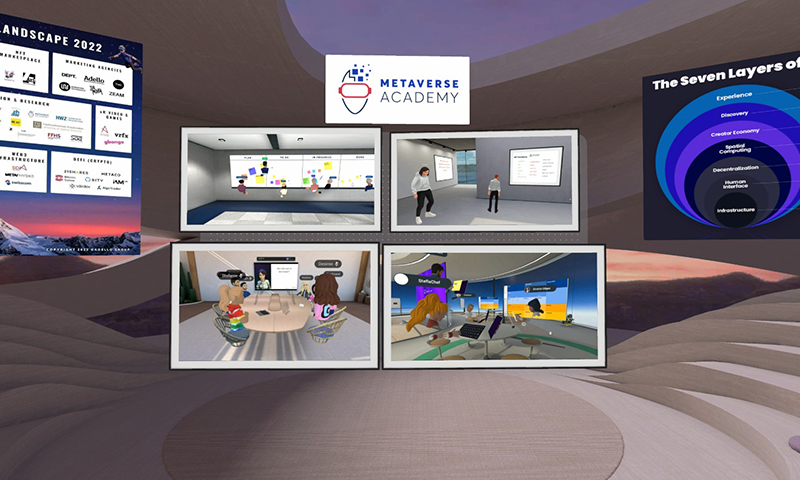Dr. Martha Boeckenfeld is a Metaverse Strategist, Advisor and Speaker, who is passionate about Emerging Tech, Blockchain and the Metaverse, and a strong believer in the Power of Innovation. She helps companies to enter the web3, the Metaverse and NFT space, where they can extend their brand presence, offering, and creativity, maximizing engagement with their clients and employees while reinventing their business verticals from Web2 to Web3.
She is a seasoned financial service professional with a PH. D and extensive experience of the platform economy, dynamic ecosystems, digital business, digital transformation, and customer experience. She has over 20 years of experience and international exposure (Asia, Europe, Switzerland) as Financial Service Executive and Non-Executive in Institutions, such as UBS, UniCredit, Blackrock, Generali, Kleinwort Benson and Axa. She is a strong believer in diversity and inclusion and Ambassador for AllStarsWomen NFT Club and DAO, women, and several other female empowering communities.
As a Dean & Partner in the Metaverse Academy, she enables companies and individuals to be part of the exciting future through community building and actively engaging in the metaverse. She has been nominated as one of the Top100 Women of The Future (Featured for Web3 & Metaverse), Top5 Women in Tech Europe (Web3). Top 32 Influencer & Thought Leader Metaverse by Onalytic
In an exclusive interview with Digital First Magazine, Dr. Martha Boeckenfeld reveals the top 3 Web 3.0 trends to watch out for in 2023. She also sheds light on Metaverse and the stepwise process she uses to help companies create and operate their Metaverse and Web3 strategy. Following are the excerpts from the interview.
According to you, what are the top 3 Web 3.0 trends to watch out for in 2023?
Let’s define Web3 first: Web3 covers technologies like blockchain, cryptocurrencies, non-fungible tokens (NFTS) and decentralized autonomous organization (DAOs). These provides us with new possibilities to create virtual spaces, which we truly own and in those spaces, we can create more democracy.
In my view the three trends to watch are:
AR/VR – The access to the metaverse usually is via mobile, desktop or VR headset. Apple is working on AR/VR glasses, which will fundamentally change the way we can use augmented reality and interact in virtual worlds. I would however not expect mass adoption at this point as this technology will be fairly expensive at the beginning.
NFTs are currently well know through the sale of digital artwork for millions of dollars. More importantly is the “utility” of NFTs for other use cases such as digital identity, real goods, and assets (e.g. real estate). Brands like Nike have already started to create phygital goods, Breitling is using NFTs for a digital twin of their wallet, Starbucks for a loyality program. NFT use cases will go beyond the hype of digital art and new utilities will be more widely used.
I would expect more government interaction, regulation, cyberisk prevention as regulation is far behind the technological advancements of Web3.
What does ‘Metaverse’ mean to you? And why are more and more companies exploring the commercial potential of the Metaverse?
To its full extent, right now the Metaverse is a vision. The Metaverse is the future of the internet: A massively scaled persistent, interactive, and interoperable real-time platform that creates a bridge between interconnected virtual worlds and real world where people can socialize, work, transact, play, and create (inspired by Mathew Ball).
Companies are trying to catch up and capture the growth opportunity. The Metaverse economy is estimated to grow into a trillion Dollar economy- According to McKinsey, the metaverse could be worth $5 trillion by 2030 and is potentially the biggest new growth opportunity for several sectors in the coming decade that include consumer packaged goods, retail, financial services, technology, manufacturing, and healthcare. Even though, we are just at the beginning, companies clearly understand the asymmetrical risk of being left behind versus the incremental value of the investment needed to explore this new landscape.
Please tell us about the Metaverse Academy. What are its objectives and vision?
We are passionate about education and believe that education makes us better human beings. Research has shown that Web3 reimagines the learning process. We are using the power of the Metaverse to create immersive learning experiences that inspire creativity, collaborate and critical thinking. From primary and higher education to girls’ education, literacy levels and tech skilling, the possibilities are limitless.
Web3 and the Metaverse allows also more access and inclusion. Girls’ education exemplifies the present-day limitations and possibilities in Web3, the lack of access has been the biggest hindrance. With the right support from authorities, the next-generation internet can completely revamp the learning process.
We have been overwhelmed by the positive response of our experiences offered and are delighted that we could take already over 500 people into virtual world experiences.
In today’s highly competitive market, why brand authenticity is important?
Brands need to create trust and act with a clear purpose. Quite often this is connected with education and creating a community. Take for example Nike, Nike created a sophisticated, interactive space within a popular digital gaming environment.
The global athletic brand launched a proprietary virtual world called “Nikeland” on the popular Roblox digital gaming platform. Virtual buildings and fields inside Nikeland are based on the company’s real-life Beaverton, Ore., headquarters,and hold detailed arenas where Roblox players compete in various mini-games.
At launch, consumers could participate in virtual games such as tag, the floor is lava, and dodgeball with their friends. With the Nikeland tool kit, users can design their own mini-games from interactive sports materials. In addition, the Nikeland virtual experience is enhanced by real-life movement. They even had a baseball Pro giving Baseball lessons in the game. Nikeland attracted 7m users within only a few months. Nike is no longer about selling a product but living healthy and providing learning to their community- “Magic Is In The Air” lets people thrive.

You are an Ambassador for AllStarsWomen DAO. Can you please tell us about the organization and your role in them?
𝗙𝗼𝗿 𝗺𝗮𝗻𝘆, 𝘁𝗵𝗲 𝗺𝗲𝘁𝗮𝘃𝗲𝗿𝘀𝗲 𝗺𝗲𝗮𝗻𝘀 𝗽𝗼𝘁𝗲𝗻𝘁𝗶𝗮𝗹 𝗳𝗼𝗿 𝗮𝗻 𝗲𝘅𝗰𝗶𝘁𝗶𝗻𝗴 𝗳𝘂𝘁𝘂𝗿𝗲. But the meta-society is facing some of the same intractable issues we do in real life. McKinsey & Company senior partner Lareina Yee and her co-author, partner Mina Alaghband, point to a discernable gender gap in metaverse leadership.
Analyzing a range of data on the early-stage metaverse, Lareina Yee found that women are just as likely to spend time in the metaverse as men, and are more likely than men to spearhead metaverse initiatives.
BUT: Leadership, the gender gap reflects one that exists in Fortune 500 companies, where less than 10 percent of CEOs are women.
The AllStarsWomen DAO, is a platform offering all the resources women need to thrive in their careers or their venture journey with a comprehensive ecosystem comprised of; A Startup Factory, providing special women centric leadership mentoring programs, in collaboration with our partners Mission Impact, and access to an accelerator program with selected companies receiving funding. The focus is on diversity and inclusion and making women thrive.
Not only as part of this community, but as a more broader ambition, my mission is to encourage women to be active in the web3 space and experience web3, nfts and the metaverse themselves to capture the opportunity for their future growth. To achieve my mission, I am engaged in a number of initiatives supporting women to become mindful leaders.
As an expert advisor, how do you help companies create and operate their Metaverse and Web3 strategy? Can you briefly tell us about the process?
We first start with a workshop to discover and ideate what the company is trying to achieve. Every innovation has to be based upon the purpose of the company, what are they good at and what are their core believes.
- Define your goals. Why do you want to be part of the metaverse? If your brand’s consumers are there, do you want to increase awareness among new audiences, newly position your brand or increase the loyality for your existing customers for the near term, the primary goal of brands shouldn’t be driving sales directly, since sales of virtual items are still far smaller than sales of physical ones. Today’s metaverse audiences, especially on online entertainment platforms like Roblox, often attract younger audience- a way to capture the NextGen and meet them where they are active.
- Identify the virtual spaces, where there is the right fit. Right now, Roblox, Fortnite, Decentral and, Minecraft, and Meta’s Horizon Worlds are just a few of the metaverse games and platforms. Some will be better than others for specific purposes. Consider building your virtual world. There is ample opportunity to experiment with multiple platforms to see what works. For example, the luxury brand Gucci has conducted multiple brand activations to figure out where and how to connect with Gen Z. Last year, it drew 19.9 million visitors in two weeks when it launched a metaverse version of its real-world Gucci Garden on Roblox. Gucci has also partnered with the fashion-focused metaverse Zepeto, announced plans to launch a virtual world on the blockchain-based platform The Sandbox, and created assets for games including The Sims, Pokémon GO, and Animal Crossing.
- Create experiences, which are innovative. Consumers consider brands, which are active in the metaverse as innovative, and the experiences delivered so far by big fashion brand like Nike through their acquisition with RFTK and Gucci are highly innovative. Therefore, the bar for delivering innovative experiences is high. Companies need to determine the ideal balance between native advertising, immersive experiences (including games, virtual stores, events, and sponsorships), and real-world activations to complement the metaverse. In addition, they need to consider, how they want to create a roadmap and connect with their web2 offering- for example through physical goods ordered in the metaverse and NFTs.
- Experiment with models, which generate revenues. Nike through RFTK has earned $181 million. Direct sales may not be front and center on the metaverse right now, but that doesn’t mean brands shouldn’t be thinking ahead and planning to capture the future potential. Direct-to-avatar sales of virtual goods are already a $54 billion market, and some forward-thinking brands are testing different opportunities to generate revenues. Forever 21, for example, sells a beanie in Roblox for under a dollar. For the high end, luxury fashion- virtual fashion is also more sustainable way of interaction with brands. Nike is trying out unique NFTs with its release of Nike Cryptokicks (a virtual model of its Nike Dunk sneakers), designed by the creative studio RTFKT, which Nike acquired in December. Nike also released a hoodie with virtual augmented wings (to be used in virtual worlds and a real hoodie) and just recently created their own marketplace, where everyone can become a creator.
- Rethink how you measure marketing success. Critical to measure the returns on marketing, but the appropriate metrics for the metaverse will depend on a different matrix using behavioral analytics- also bearing in mind that we are at a very early stage. The most important part is creating a community, where new experiences can be evolved by the community rather than the brand.
What is your secret to striking a work-life balance?
I like to be outdoors and enjoy nature, spending times with friends and family and reading books. Being with people of all ages, is the most energizing and inspiring for me.
One piece of advice you would like to give to aspiring women leaders.
Be passionate about what you do and how you do it. Surround yourself with mindful people, who give you good energy and from whom you learn- take a risk and be prepared to fail to enter new territories to learn from the experience.






